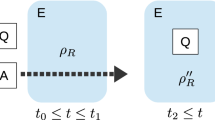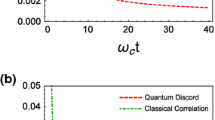Abstract
Temporal nonlocality of a two-level system interacting with a thermal reservoir is studied in terms of the Leggett–Garg inequality and the quantum witness, where the dephasing coupling and the Ohmic-like spectral density are assumed for an system-reservoir interaction. When the whole system is initially in the thermal equilibrium state, which is a quantum-classical correlated state, violation of the Leggett–Garg inequality and the quantum witness are investigated in detail. It is shown how the time evolution of the temporal nonlocality depends on the system-reservoir coupling strength, the reservoir temperature and the Ohmicity parameter. The results are compared with those obtained for a non-correlated initial state, where the two-level system and the thermal reservoir are initially in their own thermal equilibrium states. The comparison reveals that ignoring the initial correlation yields an additional phase shift in two-time correlation functions of the two-level system. The effect of the system-reservoir initial correlation becomes more significant as the Ohmicity parameter is smaller.







Similar content being viewed by others
References
Baumgratz, T., Cramer, M., Plenio, M.B.: Quantifying coherence. Phys. Rev. Lett. 113, 140401 (2014)
Streltsov, A., Adesso, G., Plenio, M.B.: Quantum coherence as a resource. Rev. Mod. Phys. 89, 041003 (2014)
Bell, J.S.: Speakable and Unspeakable in Quantum Mechanics. Cambridge University Press, Cambridge (1987)
Brunner, N., Cavalcanti, D., Pironio, S., Scarani, V., Wehner, S.: Bell nonlocality. Rev. Mod. Phys. 86, 419 (2014)
Cavalcanti, D., Skrzypczyk, P.: Quantitative relations between measurement incompatibility, quantum steering, and nonlocality. Phys. Rev. A 93, 052112 (2016)
McCloskey, R., Ferraro, A., Paternostro, M.: Einstein–Podolsky–Rosen steering and quantum steering ellipsoids: optimal two-qubit states and projective measurements. Phys. Rev. A 95, 012320 (2017)
Horodecki, R., Horodecki, P., Horodecki, M., Horodecki, K.: Quantum entanglement. Rev. Mod. Phys. 81, 865 (2009)
Peres, A.: Quantum Theory: Concepts and Methods. Kluwer, Dordrecht (1993)
Aharonov, Y., Rohrlich, D.: Quantum Paradoxes: Quantum Theory for the Perplexed. Wiley-VCH, Weinheim (2005)
Einstein, A., Podolski, B., Rosen, N.: Can quantum-mechanical description of physical reality be considered complete? Phys. Rev. 47, 777 (1935)
Reid, M.D., Drummond, P.D., Bowen, W.P., Cavalcanti, E.G., Lam, K.P., Bachor, H.A., UAndersen, U.L., Leuchs, G.: The Einstein–Podolsky–Rosen paradox: from concepts to applications. Rev. Mod. Phys. 81, 1727 (2009)
Nielsen, M.A., Chuang, I.L.: Quantum Communication and Quantum Information. Cambridge University Press, Cambridge (1987)
Jeager, G.: Quantum Information. Springer, Berlin (2007)
Leggett, A.J., Garg, A.: Quantum mechanics versus macroscopic realism: Is the flux there when nobody looks? Phys. Rev. Lett. 54, 857 (1985)
Leggett, A.J.: Realism and the physical world. Rep. Prog. Phys. 71, 022001 (2008)
Emary, C., Lambert, N., Nori, F.: Leggett–Garg inequalities. Rep. Prog. Phys. 77, 016001 (2014)
Goggin, M.E., Almeida, M.P., Barbieri, M., Lanyon, B.P., O’brien, J.L., White, A.G., Pryde, G.J.: Violation of the Leggett–Garg inequality with weak measurements of photons. Proc. Natl. Acad. Sci. 108, 1256 (2011)
Dressel, J., Broadbent, C.J., Howell, J.C., Jordan, A.N.: Experimental violation of two-party Leggett–Garg inequalities with semiweak measurements. Phys. Rev. Lett. 106, 040402 (2011)
Xu, J., Li, C., Zou, X., Guo, G.: Experimental violation of the Leggett–Garg inequality under decoherence. Sci. Rep. 1, 101 (2011)
Athalye, V., Roy, S.S., Mahesh, T.S.: Investigation of the Leggett–Garg inequality for precessing nuclear spins. Phys. Rev. Lett. 107, 130402 (2011)
Katiyar, H., Shukla, A., Rao, K., Mahesh, T.S.: Violation of entropic Leggett–Garg inequality in nuclear spins. Phys. Rev. A 87, 052102 (2013)
Palacios-Laloy, A., Mallet, F., Nguyen, F., Berlet, P., Vion, D., Esteve, D., Korotkov, A.: Experimental violation of a Bell’s inequality in time with weak measurement. Nat. Phys. 6, 442 (2010)
Knee, G.C., Kakuyanagi, K., Yeh, M., Matsuzaki, Y., Toida, H., Yamaguchi, H., Saito, S., Leggett, A.J., Munro, W.J.: A strict experimental test of macroscopic realism in a superconducting flux qubit. Nat. Commun. 7, 13253 (2016)
Thenabadu, M., Reid, M.D.: Leggett–Garg tests of macrorealism for dynamical cat states evolving in a nonlinear medium. Phys. Rev. 99, 032125 (2019)
Feller, W.: An Introduction to Probability Theory and Its Applications. Wiley, New York (1968)
Li, C.M., Lambert, N., Chen, Y.N., Chen, G.Y., Nori, F.: Witnessing quantum coherence: from solid-state to biological systems. Sci. Rep. 2, 885 (2012)
Schild, G., Emary, C.: Maximum violations of the quantum-witness equality. Phys. Rev. A 92, 032101 (2015)
van Kampen, N.G.: Stochastic Processes in Physics and Chemistry. Elsevier, Amsterdam (1983)
Kubo, R., Toda, M., Hashitsume, N.: Statistical Physics II. Springer, Berlin (1985)
Weiss, U.: Quantum Dissipative Systems. World Scientific, Singapore (1993)
Breuer, H.P., Petruccione, F.: The Theory of Open Quantum Systems. Oxford University Press, Oxford (2006)
Lobejko, M., Luczka, J., Dajka, J.: Leggett–Garg inequality for qubits coupled to thermal environment. Phys. Rev. A 91, 042113 (2015)
Friedenberger, A., Lutz, E.: Assessing the quantumness of a damped two-level system. Phys. Rev. A 95, 022101 (2017)
Ban, M.: Two-time correlations functions and quantumness of an open two-level system. Eur. Phys. J. D 73, 12 (2019)
Chen, P., Ali, M.M.: Investigating Leggett–Garg inequality for a two level system under decoherence in a non-Markovian dephasing environment. Scr. Rep. 4, 6165 (2014)
Royer, A.: Reduced dynamics with initial correlations, and time-dependent environment and Hamiltonians. Phys. Rev. Lett. 77, 3272 (1996)
Štelmachoviç, P., Bužek, V.: Dynamics of open quantum systems initially entangled with environment: beyond the Kraus representation. Phys. Rev. A 64, 062106 (2001)
Xu, G.F., Liu, L.J., Tong, D.M.: Effect of preparation procedures on the system’s entanglement evolution. Euro. Phys. J. D 66, 236 (2012)
Chaudhry, A.Z., Gong, J.: Amplification and suppression of system-bath-correlation effects in an open many-body system. Phys. Rev. A 87, 012129 (2013)
Gao, Y.: The dynamical role of initial correlation in the exactly solvable dephasing model. Eur. Phys. J. D 67, 183 (2013)
Chaudhry, A.Z., Gong, J.: Role of initial system-environment correlations: a master equation approach. Phys. Rev. A 88, 052107 (2013)
Kitajima, S., Ban, M., Shibata, F.: Expansion formulas for quantum master equations including initial correlation. J. Phys. A 50, 125303 (2017)
Morozov, V.G., Mathey, S., Röpke, G.: Phys. Rev. A 85, 022101 (2012)
Luczka, J.: Spin in contact with thermostat: exact reduced dynamics. Physica A 167, 919 (1990)
Modi, K., Brodutch, A., Cable, H., Paterek, T., Vedral, V.: The classical-quantum boundary for correlations: discord and related measures. Rev. Mod. Phys. 84, 1655 (2012)
Brun, T.A.: A simple model of quantum trajectories. Am. J. Phys. 70, 719 (2002)
Saha, D., Mal, S., Panigrahi, P.K., Home, D.: Wigner’s form of the Leggett–Garg inequality, the no-signaling-in-time condition, and unsharp measurements. Phys. Rev. A 91, 032117 (2015)
Barnett, S.M.: Quantum Information. Oxford University Press, Oxford (2009)
Wiseman, H.M., Milburn, G.I.: Quantum Measurement and Control. Cambridge University Press, Cambridge (2010)
Srinivas, M.D.: Measurements and Quantum Probabilities. Universities Press, Hyderabad (2001)
Luo, S., Fu, S., Song, H.: Quantifying non-Markovianity via correlations. Phys. Rev. A 86, 044101 (2012)
Hall, H., Cresser, J., Li, L., Andersson, E.: Canonical form of master equations and characterization of non-Markovianity. Phys. Rev. A 89, 042120 (2014)
Wang, C., Li, C., Guo, Y., Lu, G., Ding, K.: Environment and initial state engineered dynamics of quantum and classical correlations. Ann. Phys. 374, 212 (2016)
Olver, F.W.J., Lozier, D.W., Boisvert, R.F., Clark, C.W.: NIST Handbook of Mathematical Functions. Cambrige Unversity Press, Cambridge (2010)
Author information
Authors and Affiliations
Corresponding author
Additional information
Publisher's Note
Springer Nature remains neutral with regard to jurisdictional claims in published maps and institutional affiliations.
Appendices
Derivation of \(\langle V(t_{j},t_{k})\rangle \) and \(\langle V(t_{j},t_{k})\sigma _{z}\rangle \) in Sects. 3 and 4
In this “Appendix”, we calculate the average values \(\langle V(t_{j},t_{k})\rangle \) and \(\langle V(t_{j},t_{k})\sigma _{z}\rangle \) which are used to examine the Leggett–Garg inequality and the quantum witness in Sects. 3 and 4. First, substituting Eq. (2) into (9) and using the commutation relation of bosonic annihilation and creation operators, we can rewrite the operator \(V(t_{j},t_{k})\) into
where \(C_{k}(t_{j}-t_{k}){=}(2g_{k}/i\omega _{k})(\text {e}^{i\omega _{k}(t_{j}-t_{k})}-1)\) and \(\mathrm {T}_{\leftarrow }\) (\(\mathrm {T}_{\rightarrow }\)) stands for the time-ordering (the ant-time-order) operation. Then, using Eq. (3), we obtain the average value of Eq. (45),
The real and imaginary parts in the exponentials are calculated to be
and
Then, Substituting these equations into Eq. (46), we obtain the average value,
which yields Eq. (19). In the same way, we can derive the average value,
from which we can obtain Eq. (36).
Derivation of the parameters \(\phi (t)\), \(\gamma (t)\) and \({\dot{\gamma }}(t)\)
When the thermal reservoir has the Ohmic-like spectral density (22), we derive Eqs. (23)–(26) and (28). First, substituting Eq. (22) into (20) and (21), we obtain \(\gamma (t)=\gamma _{0}(t)+\gamma _{1}(t)\) and \({\dot{\gamma }}(t)={\dot{\gamma }}_{0}(t)+{\dot{\gamma }}_{1}(t)\) with
and
In these equation, we set \(a=\varOmega t\) and \(b=\hbar \varOmega /kT\) for the sake of simplicity. To calculate the integral on the right-hand side of Eq. (51), we first differentiate \(\gamma _{0}(t)\) with respect to the parameter a and then perform the integration with respect to x first and then a. Hence after straightforward calculation, we find that
for \(s=1\) and
for \(s\ne 1\). In this equation, \(\varGamma (z)\) is the gamma function. Furthermore, we note that the relations \(\cos (u\tan ^{-1}v)=\mathrm {Re}(1+iv)^{u}/(1+v^2)^{u/2}\) and \(\sin (u\tan ^{-1}v)=\mathrm {Im}(1+iv)^{u}/(1+v^2)^{u/2}\) hold for real parameters u and v. Then we finally obtain \(\gamma _{0}(t)=\frac{1}{2}\lambda \ln [1+(\varOmega t)^{2}]\) for \(s=1\) and \(\gamma _{0}(t)=\lambda \varGamma (s-1)f_{s}(\varOmega t)\) for \(s\ne 1\), where \(f_{s}(z)\) is given by Eq. (27).
Next, to calculate the integral on the right-hand side of Eq. (52), expanding \(\coth bx/2\) into a power series of \(\text {e}^{-bx}\), we obtain \(\gamma _{1}(t)=2\lambda \sum _{n=1}^{\infty }f_{n}(t)\) with
which can be calculated in the same way used for deriving \(\gamma _{0}(t)\). In the case of \(s=1\), we obtain
which yields
where we have used [54]
Thus we find that \(\gamma (t)=\gamma _{0}(t)+\gamma _{1}(t)\) is equal to Eq. (23) for \(s=1\). On the other hand, when \(s\ne 1\), \(f_{n}(t)\) is calculated to be
Then we obtain
which shows that \(\gamma (t)=\gamma _{0}(t)+\gamma _{1}(t)\) is equal to Eq. (25) for \(s\ne 1\).
The time-derivative \({\dot{\gamma }}(t)\) can be calculated directly. In fact, we can derive
where \(g_{s}(z)\) is given by Eq. (29). Thus we have derived Eq. (28). Finally, in the same way for deriving the parameter \(\gamma _{0}(t)\), the phase parameter \(\phi (t)\) is calculated to be
which is equal to Eqs. (24) and (26).
Derivation of the correlation functions in Sect. 5
We calculate \(\langle V(t_{j},t_{0})V^{\dagger }(t_{k},t_{0})\rangle _{R}\), \(\langle V^{\dagger }(t_{j},t_{0})V(t_{k},t_{0})\rangle _{R}\), \(\langle V(t_{k},t_{0})V^{\dagger }(t_{j},t_{0})\rangle _{R}\) and \(\langle V^{\dagger }(t_{k},t_{0})V(t_{j},t_{0})\rangle _{R}\) used to examine the violation of the Leggett–Garg inequality and the quantum witness for the non-correlated initial state in Sect. 5. First we calculate the correlation function \(\langle V(t_{j},t_{0})V^{\dagger }(t_{k},t_{0})\rangle _{R}\). From Eq. (45), we obtain
with
where \(\phi (t_{j}-t_{k})\) is given by Eq. (21) or (48) and \(\delta _{jk}\) is given by Eq. (40). Since the thermal reservoir is in the equilibrium state \(\rho _{R}=\text {e}^{-H_{R}/k_{\mathrm {B}}T}/\mathrm {Tr}\text {e}^{-H_{R}/k_{\mathrm {B}}T}\), the average value of the exponential including the annihilation and creation operators in Eq. (66) is calculated to be
Hence we obtain the correlation function,
In the same way, we can derive
Taking complex conjugate of Eqs. (69) and (69), we obtain
Therefore we have derived the correlation functions given by Eqs. (39) and (43).
Rights and permissions
About this article
Cite this article
Usui, R., Ban, M. Temporal nonlocality of a two-level system interacting with a dephasing environment. Quantum Inf Process 19, 159 (2020). https://doi.org/10.1007/s11128-020-02656-y
Received:
Accepted:
Published:
DOI: https://doi.org/10.1007/s11128-020-02656-y




